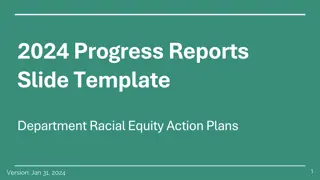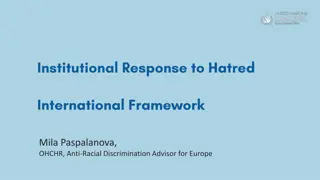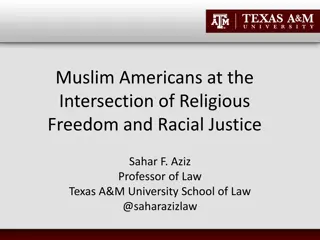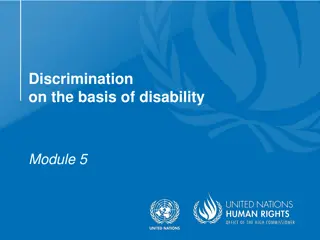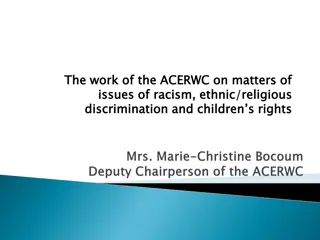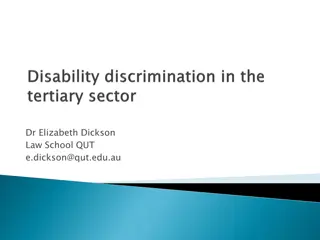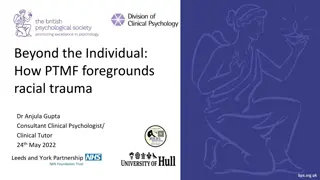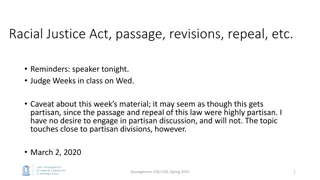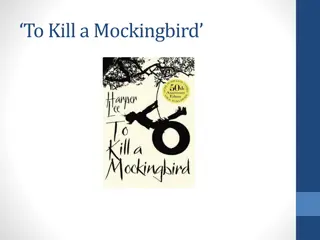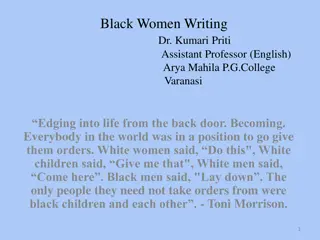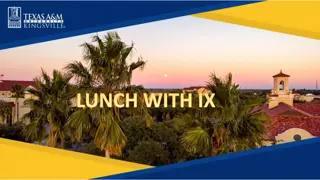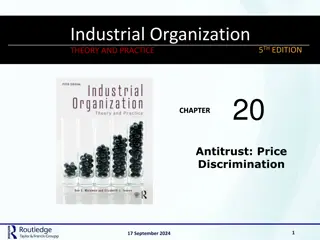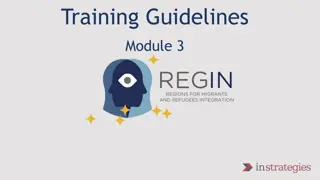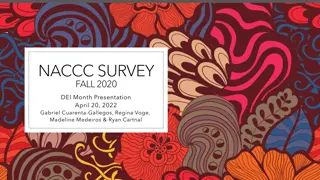The Legacy of Racial Discrimination in Education
Explore the historical context of racial discrimination in education, focusing on the experiences of African Nova Scotian (ANS) learners. From the establishment of segregated schools to the lack of access to quality education and decent employment opportunities, uncover the challenges faced by ANS individuals. Learn about initiatives like the Black Learners Advisory Committee and the BLAC Report that shed light on the systemic issues within the education system. Delve into the importance of creating a safe space for discussions on race and culture to address these disparities effectively.
Download Presentation

Please find below an Image/Link to download the presentation.
The content on the website is provided AS IS for your information and personal use only. It may not be sold, licensed, or shared on other websites without obtaining consent from the author.If you encounter any issues during the download, it is possible that the publisher has removed the file from their server.
You are allowed to download the files provided on this website for personal or commercial use, subject to the condition that they are used lawfully. All files are the property of their respective owners.
The content on the website is provided AS IS for your information and personal use only. It may not be sold, licensed, or shared on other websites without obtaining consent from the author.
E N D
Presentation Transcript
Mocking Birds, Literacy Rates, Cultural Competence and Racism Informed Education Robert S. Wright, MSW, RSW Lecturer, MSVU Child & Youth Studies Social Worker in Private Practice www.robertswright.ca
Who is Robert Wright? Lecturer, MSVU, CHYS, Afrocentric Cohort in MEd LLL Registered social work private practitioner (NS, NB) Former Student Support Worker, Halifax Reg. SB Clinical training at, & employee of WA State Pen. Former executive director, Child & Youth Strategy Member, MHCC Diversity Task Group Former Race Relations Coord. Dart. DSB Co-author: Prevention and treatment of addictions among North Americans of African descent.
Todays Task History of ANS Learners Resistance, Reform, Advocacy The BLAC Report Current state of ANS Learners What teachers can do The Role of the BCC
Drawing a Circle of Safety Issues of race and culture are highly charged in North America. It is my hope that in this session individuals will allow each other space to ask their sincere questions without the fear of being judged and accused. Similarly, people may also feel that the subject matter is so close to them that they need to be assured that they are not being singled out or expected to have all the answers . . . What can we do to ensure that we conduct this session in a way that ensures your safety?
History of ANS Learners Schools in Canada were never established to be egalitarian institutions Established as segregated institutions, along religious lines and later, racial lines Last segregated school in Canada was closed in Guysborough in 1983
The Legacy of Racial Discrimination Historically, ANS have had: Little access to quality education Little decent employment opportunities To live in low income, with all of its negative consequences Lack of race relations policies Lack of culturally specific curriculum Need for teacher training and appropriate resources
Black Learners Advisory Committee Black Educators Association formed in 1969 Advocates for study into the conditions of ANS Learners Takes 20 years but in 1989 a Provincial Advisory Committee is appointed, renamed as BLAC BLAC Report demonstrates vividly, the realities of the African Nova Scotian experience in a discordant education system that is devoid of any effective policies that are essential and sympathetic to their needs (BLAC, 1994, p. 13). BLAC s 30 recommendations were accepted by Government CACE, ALI, ACSD, Anti-racist education policies, financial assistance to ANS post-secondary students, designated seats for ANS Learners
Current State of ANS Learners Despite desegregation, Black schools, poor schools, good schools, bad schools still exist in Nova Scotia . . . The legacy of catholic schools, protestant schools, I m glad to report is almost over Still lowest literacy rates are in largely Black Schools IBM programme, TYP, Designated seats in education and NSCC programmes never have been fully filled Drop out rates still higher, post secondary education uptake still lower
What Teachers Can Do Let me ask the question . . . Should To Kill a Mockingbird be Taught in Public Schools in Nova Scotia Today? If no . . . Why not? If yes . . . Could you teach it? What is the comparable question in elementary education?
Beyond Cultural Competence Cultural competence refers to an ability to interact effectively with people of different cultures. Cultural competence comprises four essential capacities: We must understand our cultural differences and similarities We must understand the social and cultural reality in which we work*** We must cultivate appropriate attitudes towards cultural difference We must be able to generate and interpret a wide variety of verbal and non-verbal responses. Cultural Competence is essential . . . And not an easy thing . . . Consider . . .
T TH HE E P PH HI IL LO OS SO OP PH HI IC CA AL L A AS SP PE EC CT TS S O OF F C CU UL LT TU UR RA AL L D DI IF FF FE ER RE EN NC CE EDEVELOPED BY EDWIN J.NICHOLS,PH.D. A AX XI IO OL LO OG GY Y E EP PI IS ST TE EM P PE ED DA AG GO OG GY Y MO OL LO OG GY Y L LO OG GI IC C P PR RO OC CE ES SS S E ET TH HN NI IC C G GR RO OU UP PS S E ET TH HN NI IC C WO OR RL LD DV VI IE EW A AP PP PL LI IE ED D M ME ET TH HO OD DO OL LO OG GY Y W W M Me em mb be er r- -O Ob bj je ec ct t T Th he e h hi ig gh he es st t v va al lu ue e l li ie es s i in n t th he e o ob bj je ec ct t o or r t th he e a ac cq qu ui is si it ti io on n o of f t th he e o ob bj je ec ct t P Pa ar rt ts s t to o W Wh ho ol le e D Di ic ch ho ot to om mo ou us s E Ei it th he er r/ /O Or r - -N Ne ew wt to on ni ia an n t th he eo or ry y- - O On ne e k kn no ow ws s t th hr ro ou ug gh h C Co ou un nt ti in ng g a an nd d M Me ea as su ur ri in ng g L Li in ne ea ar r a an nd d S Se eq qu ue en nt ti ia al l - -A As ss se em mb bl ly y l li in ne e- - A Al ll l s se et ts s a ar re e r re ep pe ea at ta ab bl le e a an nd d r re ep pr ro od du uc ci ib bl le e - -T Te ec ch hn no ol lo og gy y- - E EU UR RO OP PE EA AN N E EU UR RO O- -A AM ME ER RI IC CA AN N M Me em mb be er r- -M T Th he e h hi ig gh he es st t v va al lu ue e l li ie es s i in n t th he e r re el la at ti io on ns sh hi ip ps s b be et tw we ee en n p pe er rs so on ns s Me em mb be er r W Wh ho ol le e H Ho ol li is st ti ic c T Th hi in nk ki in ng g - -T Th he e B BI IG G p pi ic ct tu ur re e- - O On ne e k kn no ow ws s t th hr ro ou ug gh h S Sy ym mb bo ol li ic c I Im ma ag ge er ry y a an nd d R Rh hy yt th hm m ( (f fu un nc ct ti io on n) ) - -G Gl la ad dw we el ll l B Bl li in nk k- - D Di iu un ni it ta al l U Un ni io on n o of f o op pp po os si it te es s D Di if fr ra as si is sm mo o - -A Az zt te ec c t th ho ou ug gh ht t- - T Th he e I In n B Be et tw we ee en n Ibn Arabi - -Q Qu ua an nt tu um m t th he eo or ry y- - C Cr ri it ti ic ca al l P Pa at th h a an na al ly ys si is s - -C Cu ut t t to o t th he e c ch ha as se e- - A Al ll l s se et ts s a ar re e i in nt te er rr re el la at te ed d t th hr ro ou ug gh h h hu um ma an n a an nd d s sp pi ir ri it tu ua al l n ne et tw wo or rk ks s - -B Bl la ac ck k c ch hu ur rc ch h- - A AF FR RI IC CA AN N A AF FR RI IC CA AN N A AM L LA AT TI IN NO O/ /A A A AR RA AB B ME ER RI IC CA AN N M Me em mb be er r- -G Gr ro ou up p T Th he e h hi ig gh he es st t v va al lu ue e l li ie es s i in n t th he e c co oh he es si iv ve en ne es ss s o of f t th he e g gr ro ou up p N Ny ya ay ya a - -T Th he e o ob bj je ec ct ti iv ve e w wo or rl ld d i is s c co on nc ce ei iv ve ed d i in nd de ep pe en nd de en nt t o of f t th ho ou ug gh ht t a an nd d m mi in nd d- - - -C Ch ha ao os s t th he eo or ry y- - G Gr re ea at t M My ys st te er ry y - -A A s se et t o of f 4 4 a an nd d a a s se et t o of f 3 3 f fo or rm m t th he e w wh ho ol le e- - - -S Su up pe er r s st tr ri in ng g t th he eo or ry y- - O On ne e k kn no ow ws s t th hr ro ou ug gh h T Tr ra an ns sc ce en nd de en nt ta al l S St tr ri iv vi in ng g - -T Tr re ee e t th he e f fo or re es st t- - W Wh ho ol le e a an nd d p pa ar rt ts s a ar re e s se ee en n s si im mu ul lt ta an ne eo ou us sl ly y - -T To o r re ea ad d a a C Ch hi in ne es se e w wo or rd d- - C Cy yc cl li ic ca al l a an nd d R Re ep pe et ti it ti iv ve e - -S St tr ro ok ke e o or rd de er r i in n w wr ri it ti in ng g a a C Ch hi in ne es se e w wo or rd d- - A Al ll l s se et ts s a ar re e i in nd de ep pe en nd de en nt tl ly y i in nt te er rr re el la at te ed d i in n t th he e h ha ar rm mo on ny y o of f t th he e u un ni iv ve er rs se e - -K Ke ei ir re et ts su u- - A AS SI IA AN N A AS SI IA AN N A AM P PO OL LY YN NE ES SI IA AN N ME ER RI IC CA AN N M Me em mb be er r- -G Gr re ea at t S Sp pi ir ri it t T Th he e h hi ig gh he es st t v va al lu ue e l li ie es s i in n o on ne en ne es ss s w wi it th h t th he e G Gr re ea at t S Sp pi ir ri it t O On ne e k kn no ow ws s t th hr ro ou ug gh h R Re ef fl le ec ct ti io on n a an nd d S Sp pi ir ri it tu ua al l R Re ec ce ep pt ti iv vi it ty y - -P Pu ur ri if fi ic ca at ti io on n r ri it te es s- - E En nv vi ir ro on nm me en nt ta al ll ly y e ex xp pe er ri ie en nt ti ia al l r re ef fl le ec ct ti io on n - -R Ri it te es s o of f P Pa as ss sa ag ge e- - W Wh ho ol le e i is s s se ee en n i in n c cy yc cl li ic c m mo ov ve em me en nt t - -S Se ea as so on ns s- - - -M Me ed di ic ci in ne e W Wh he ee el l- - A Al ll l s se et ts s a ar re e i in nt te er rr re el la at te ed d t th hr ro ou ug gh h t th he e e el le em me en nt ts s, , p pl la an nt t, , a an ni im ma al l, , a an nd d s sp pi ir ri it tu ua al l n ne et tw wo or rk ks s - -W Wh hi it te e B Bu uf ff fa al lo o- - N NA AT TI IV VE E A AM ME ER RI IC CA AN N
Racism Informed/Anti-racism The Problem with Cultural Competence is that it doesn t speak to the real problem . . . Racism and its living legacy We must understand the social and cultural reality in which we work*** What we mean to say is that to effectively work with historically oppressed peoples one must not only be aware of the social and cultural reality , one must be and be seen to be an active agent in the movement to challenge racism wherever it is found and be an active promoter of a Just Society
The Role of the Black Cultural Centre Not just a repository of the artifacts of ANS history A catalyst for the promotion of an ANS/afrocentric lens from which to view the challenges we have discussed. A place from which all persons should leave not only with new information, but with a new perspective, a new lens






